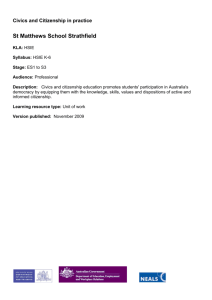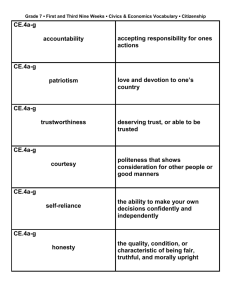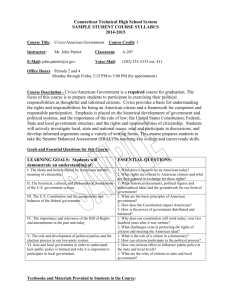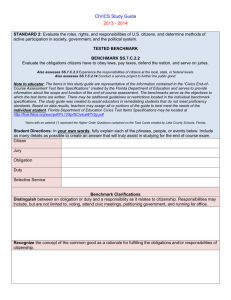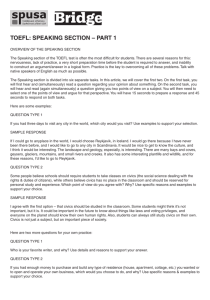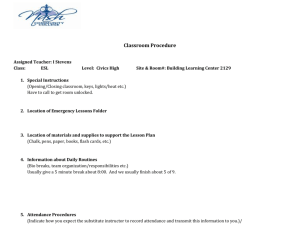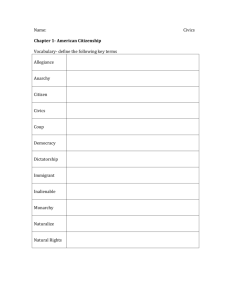Rules Verses Laws - Curriculum Team News
advertisement
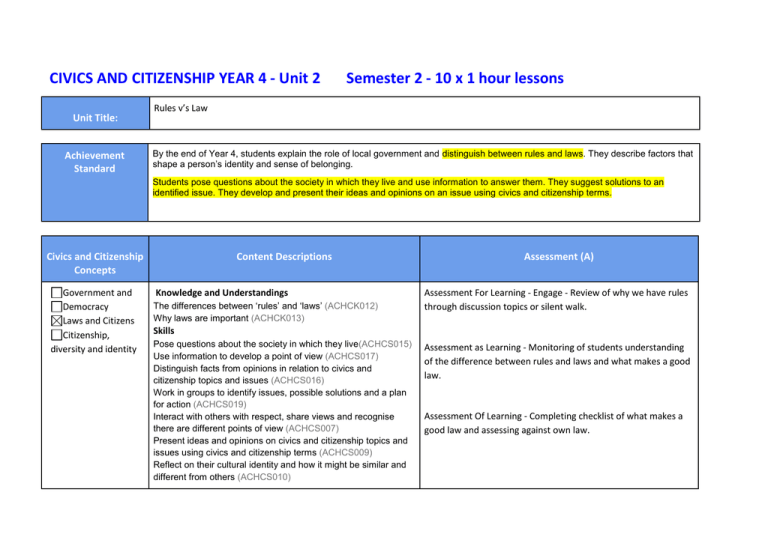
CIVICS AND CITIZENSHIP YEAR 4 - Unit 2 Unit Title: Achievement Standard Semester 2 - 10 x 1 hour lessons Rules v’s Law By the end of Year 4, students explain the role of local government and distinguish between rules and laws. They describe factors that shape a person’s identity and sense of belonging. Students pose questions about the society in which they live and use information to answer them. They suggest solutions to an identified issue. They develop and present their ideas and opinions on an issue using civics and citizenship terms. Civics and Citizenship Concepts Government and Democracy Laws and Citizens Citizenship, diversity and identity Content Descriptions Knowledge and Understandings The differences between ‘rules’ and ‘laws’ (ACHCK012) Why laws are important (ACHCK013) Assessment (A) Assessment For Learning - Engage - Review of why we have rules through discussion topics or silent walk. Skills Pose questions about the society in which they live(ACHCS015) Use information to develop a point of view (ACHCS017) Distinguish facts from opinions in relation to civics and citizenship topics and issues (ACHCS016) Work in groups to identify issues, possible solutions and a plan for action (ACHCS019) Interact with others with respect, share views and recognise there are different points of view (ACHCS007) Present ideas and opinions on civics and citizenship topics and issues using civics and citizenship terms (ACHCS009) Reflect on their cultural identity and how it might be similar and different from others (ACHCS010) Assessment as Learning - Monitoring of students understanding of the difference between rules and laws and what makes a good law. Assessment Of Learning - Completing checklist of what makes a good law and assessing against own law. Civics and Citizenship Bands Year 3 4 Band Year 5 6 Band Learning Framework Cross Curricula Priorities General Capabilities Links to other LA’s Skills Questioning and Research Analysis Synthesis and Interpretation Problem Solving and Decision Making Communication and Reflections Community Contributor Leader and Collaborator Catholic Ethos Aboriginal and Torres Strait Islander Histories and Cultures Literacy Critical and Creative Thinking Intercultural Understanding History - Ancient Rome English - Dreaming Stories Key Questions What is the difference between rules and laws and why are they important? Active Investigator Effective Communicator Social Emotional Learning Asia and Australia’s Engagement with Asia Numeracy Ethical Understanding Designer and Creator Quality Producer Inclusive Education Sustainability Education ICT Personal and Social Capability Learning and Teaching Strategies Week 1 Cross Curricular Priorities 2 3 4 5 6 7 8 9 10 Critical Creative Thinking, Ethical Understanding General Capabilities Engage ⇒ Explore ⇒ Explain ⇒ Elaborate ⇒ Engage Activity 1 - Why do we need Rules or Laws? The purpose of this activity is to tune the students into the idea of why we have rules or laws in the first place. This purpose is to be identified at the conclusion of the lesson. Teacher to hand out prepared “What if” cards to groups of 3. Students to brainstorm what might happen, what might happen next (i.e. the chain of consequences). “What if” cards samples could be: What if: - you were allowed to run on the concrete at school - your parents let you eat junk food all day - you didn’t have to put your hand up to speak in class - you were allowed to pick flowers in the local park - you played a game of netball and your referee took away the hoops and didn’t tell you why - you threw your rubbish into your local river instead of your wheelie bin - you were allowed to draw in library books - your mum and dad let you drive the car Students report back to class on their scenario and the chain of consequences. The chain of consequences should show Evaluate Resources Teacher Resources * What if cards * Jenny Naylor “Inquiry for Change” Double Circles/ SIlent Walk - Tuning in Activity Student Resources * Paper for brainstorming chain of consequences * Paper for “silent walk” negative effects. Ask students would these things happen really? Elicit idea that rules and laws stop people doing these things. Go through each scenario and discuss who makes the rule in each scenario (i.e. school, parents, teachers, council, referee). Activity 2 - Review of why we have rules Students should have learnt why we make rules in Year 3. This idea needs to be revisited (or explicitly taught) depending on where your students have come from. Assess this need by getting students to answer following questions. This could be done as a double circle - Set first discussion topic (see below) for inner circle to talk about for one minute. Set 2nd discussion topic for outer circle to talk about for one minute. Option to rotate partners between topics, e.g. inner circle move 1 to your left. This could also be done as a “silent walk” where some of questions below are written on large pieces of paper around room. Students walk around room adding comments or leaving a next tick or a question mark next to other people’s comments indicating whether they agree/disagree or don’t understand. ● ● ● ● ● ● ● ● How do rules support our rights and responsibilities and help us live together safely, justly and well? Why do we need rules and why do we need to know what they are? How do we judge what is fair or not? Do rules have to be fair for everyone? How do people know what the rules are? When and why do rules change? Who should make the rules and why? What can happen if we do not follow rules? Civics and Citizenship Metalanguage Rules, rights, responsibilities, fairness, just, consequences, equality Civics and Citizenship Metalanguage Link Assessment Opportunities Assessment For Learning Engage - Review of why we have rules through discussion topics or silent walk. Reflection Week 1 2 3 4 5 6 7 8 9 10 Cross Curricular Priorities General Capabilities Engage ⇒ Explore ⇒ Explain ⇒ Elaborate ⇒ Explore Evaluate Resources Activity 1 - What is a rule? Divide the class into 6-8 groups. Each group makes a poster showing: ● a situation where certain rules apply (give settings of school, home, library, swimming pool etc.) ● who has to obey these rules? Students should spend only about 15 mins on this. To be displayed in classroom. Monitor this activity and ensure students are choosing rules and not laws. Students feedback to class briefly on rule chosen and who obeys these rules Teacher Resources * Discovering Democracy Units: Rules v Law http://www1.curriculum .edu.au/ddunits/units/m p2rules-glance.htm Activity 2 - What is a law? Student Resources A4 paper pencils/ felts * Ask how students get to school. * Students solve this riddle, for those that come by car: I'm not a cap or coat, but you must put me on before you hit the road! What am I? Discuss: ● Why must you wear a seatbelt? ● What could happen if you do not wear a seatbelt? What are the consequences? ● What could happen if a police officer saw you without a seatbelt? ● Does everybody have to wear seatbelts in cars? * Repeat Step 2b, substituting 'helmet' for 'seatbelt' for students who ride bikes and must wear helmets by law. * Discuss what makes wearing a seatbelt or helmet a law. List the reasons on the board in a column. Ask students to suggest other laws they know and list those on the board (this could be brainstormed in small groups). Discuss why these are laws. Ask if I could make a law? Why/ not? End of Session: Reflect on what is the difference between a rule and a law? Civics and Citizenship Metalanguage Assessment Opportunities rule, law Civics and Citizenship Metalanguage Link Assessment as Learning - are students starting to see some differences between rules and law? Reflection Week 1 2 3 4 5 6 7 8 9 10 Cross Curricular Priorities General Capabilities Engage ⇒ Critical and Creative Thinking, Personal Social Capability, Ethical Undertanding Explore ⇒ Explain ⇒ Elaborate ⇒ Evaluate Explore Activity 3 - Road Laws * Distribute “What is the Law?” handout and discuss the laws depicted on the handout and who is bound to obey them. Discuss that “road rules” are actually laws because they apply to everyone. * Divide the class into small groups. Assign one of the following roles to each: ● cyclist ● parent with small child ● visually impaired man with a guide dog ● newly arrived migrant or foreign tourist ● senior citizen. * Announce the headline: 'Shock Stop! Road laws cancelled for the rest of the day!' * Each group considers the impact of not having any road laws if they had to cross the road to go shopping. ● How do you think having no road laws would affect you? ● What might happen to you? ● What care would you have to take? What care or responsibilities would others have to take? ● What do you need road laws for? * In same groups, students complete a “Consequence Tree” (see handout in Teacher Resources but if used, you will need to replace the word “rule” with “law”). * Each group selects a member to be their VOX POP (voice of the people in the street) for a brief 'radio interview' conducted by the teacher as a form of reporting back * Finish activity again by discussing what is the difference between a rule and law? Are the punishments for breaking laws generally more serious than those for breaking rules? Why is this? Can students see: Rules apply to small groups in special circumstances whereas laws apply to the broader society. * Students could work in a group of 2 or 3 to try and write a definition for a rule and law. This could alternatively be done as a whole class and displayed in room. Resources Teacher Resources Discovering Democracy Units - Rules and Laws http://www1.curriculum.edu. au/ddunits/units/mp2fq2acts .htm * DD Unit - Rules and Laws “What is the Law” handout 2 http://www1.curriculum.edu. au/ddunits/downloads/pdf/m p2_hand2.pdf *DD unit: Rules and Laws Road Laws “Consequence Tree” Handout 1 http://www1.curriculum.edu. au/ddunits/downloads/pdf/m p2_hand1.pdf Student Resources * copy of “What is Law” (or display on IWB) * each group needs a copy of “Consequence Tree” Civics and Citizenship Metalanguage Assessment Opportunities rule, law, society, punishment, road rules/ road laws, consequences, senior, foreign, migrant, tourist, Civics and Citizenship Metalanguage Link Assessment as Learning - can the students see differences between rules and law? Reflection Week 1 2 3 Cross Curricular Priorities Inclusive Education General Capabilities Personal Social Capability Engage ⇒ Explore ⇒ 4 5 Explain ⇒ 6 7 Elaborate ⇒ Explain Activity 1: Pick the rule, Pick the Law * Take students outside, walk around the school block and list evidence that students see for rules and laws that operate in the area. For example, Speed limit and 'stop' signs indicate road laws while a canteen sign might indicate a school rule. * Display “Pick the Rule, Pick the Law” on IWB so whole class can see (if IWB not available this could be distributed. Discuss whether each marked activity has a rule or law governing the situation and how do we know. To distinguish between a law and a rule, students might ask themselves, 'Does this apply to everybody in QLD or only to some people/groups?' * After class discussion, students individually complete tables in “Rule or Law” handout. Check and verify as a class whether a rule or law applies and why. 8 9 10 Evaluate Resources Teacher Resources Discovering Democracy Units - Rules and Laws http://www1.curriculum.edu.au/ddunits/units /mp2fq2acts.htm Refers to Handout 3 - “Pick the Rule, Pick the Law” and Handout 4 “Rule or Law” http://www1.curriculum.edu.au/ddunits/dow nloads/downloads.htm#mp2rules Activity 2: Is this fair? (discussion questions following this activity are very important and if short on time, should be carried over to next lesson) * Divide the class into four groups (A, B, C, D) and give each a role card cut from “Game role cards” Handout 5 (Please be aware if you have a child who will react badly to an unfair game, you may need to discuss purpose of activity beforehand) * Each group examines its role card in isolation and discusses the implications of the role on the way they play the game. Students in Group A should decide some rules for play in collaboration with the teacher. E.g. use beanbags to score “goals” (in rubbish bin for example), you can only throw with your left hand * To play, set up two teams: A team (consisting of all the 'A' players and half of each C and D players) and B team (consisting of all the 'B' players and the remaining C and D players). Explain that although there are four groups, there are only two teams and the players must play according to their roles. * After five minutes' play, return to the classroom for debriefing. * Students sit in their group and discuss the game before discussing the following questions as a whole class: ● Was this game fair? Why? Why not? ● Was this game easy to play? Why? Why not? ● Who had most of the say? ● Who was left out? ● How did you feel? (as an A, B, C, or D player) ● What if the classroom operated by this kind of system? ● What do you think each of the different groups could do to make the rules fairer? Would Group A want change? * Now get students to imagine laws. Is it fairer for only 1 person to know the laws or everyone? What might happen to you if you don’t know the laws? Is it fair if a law only applies to a small group (e.g. only people with blond hair need to do 60km/hr in town) Refer students back to laws they may be familiar with e.g. road laws. Why are they fair? i.e. We all know them; they are the same for everyone. Discuss idea of equality. Refers to Handout 5 “Game role cards” http://www1.curriculum.edu.au/ddunits/dow nloads/pdf/mp2_hand5.pdf Student Resources * Each student needs own copy of “Rule or Law” handout. * Copy of Game role cards Civics and Citizenship Metalanguage Assessment Opportunities obey laws, breaking laws, fair laws, equality Civics and Citizenship Metalanguage Link Assessment as Learning: monitor students ability to table in Activity 1: Can students * identify some differences between rules and laws * Identify some differences in the consequences of breaking rules and laws supported by reasons. Monitor discussion at end of Activity 2 - can students identify that fairness means everyone should know the rules? Reflection Week 1 2 3 4 5 6 7 8 9 10 Cross Curricular Priorities General Capabilities Engage ⇒ Intercultural Education, Ethical Understanding Explore ⇒ Explain ⇒ Elaborate ⇒ Explain Activity 3 Students expand on ideas discussed in previous lesson on what makes a law fair by examining the system of law-making present in Evaluate Resources Teacher Resources * Map or Globe Ancient Rome. Students will probably need to be shown where Rome is today and the country of Italy. Students should also be shown the ancient meeting place of Rom - the Forum (see Teacher Resources) Explain that a long time ago, Rome had a system of law-making which was similar to game played last lesson. Display and Discuss “People of Ancient Rome” handout. Can students identify which group, patricians, plebeians, women and slaves of Rome matches the role of each group A, B, C or D from the game played last lesson?. Ask students to imagine what the consequences would be if the game situation applied to daily life. Discuss what might happen if they did not know the laws. You know how hard it is to play a game if you do not know what the rules are. Imagine that you did not know the laws - you could break a law and go to gaol. Students return to their groups (A, B, C, or D) to make a placard expressing the group's view of how fair (or otherwise) they think life is when only one group knows the laws. Group A - patricians Group B - plebeians Group C - women Group D - slaves Hold a 'protest' rally in the classroom, with each group displaying and explaining its placard. Explain to students that a protest is exactly what happened in Ancient Rome. i.e. plebians became sick of unfair law-making and, after protests, laws were eventually changed. * Picture of Roman Forum http://en.wikipedia.org/ wiki/Roman_Forum * Discovering Democracy Units - Rules and Laws http://www1.curriculum .edu.au/ddunits/units/m p2fq2acts.htm Refers to Handout 6 “People of Ancient Rome” http://www1.curriculum .edu.au/ddunits/downlo ads/downloads.htm#mp Activity 4 - Ancient Rome - the 12 tables (can carry over to Week 6) The Romans first wrote their laws down (about 2,450 years ago) and displayed them in the Forum on the Twelve Tables. How did make 2rules * Poster/ IWB display of this more fair (i.e. people knew what they were) What were the laws like? Discuss some of the following examples (display on IWB or poster): sample rules from ● no-one can bury or burn a body in the city Ancient Rome ● women cannot tear their hair out or wail too much at funerals ● no-one can be executed without a trial ● a person can be forced to go to court ● a father has absolute power over his children ● no one can set fire to a house. Compare the laws on the Twelve Tables with those of today: ● Do you think that in Australia today we have laws similar to any of those above? ● How could we find out? ● Why is it important for laws to be written down? * One law on Table XI said that a patrician and a plebeian could not marry each other but this law was changed. Discuss why a law such as this might change. Could laws today change in the future? e.g. think about future scenarios such as less people on roads because more people use hover jet packs to move around. Civics and Citizenship Metalanguage Assessment Opportunities protest rally, system of law-making, unfair law-making, law changes Civics and Citizenship Metalanguage Link Assessment as Learning - monitor students understanding of what makes a “good law” Reflection Week 1 2 3 4 5 Cross Curricular Priorities Aboriginal and Torres Strait Islander Histories and Cultures General Capabilities Intercultural Understanding, Literacy Engage ⇒ Explore ⇒ Elaborate Activity 4 - Ancient Rome Complete activity from last week if required. Explain ⇒ 6 7 Elaborate ⇒ 8 9 10 Evaluate Resources Teacher Resources * Discovering Democracy Units - Rules Activity 5 - What are the laws that may be cultural to Aboriginal and Torres Strait Islanders? Ask students to list laws they have learnt about in previous activities. Remind students or have them recap why we have laws. Discuss the question: 'Would laws be the same or similar in all societies?' (Students should reach the conclusion that laws in all societies are meant to be for the good of society.) *Invite students to think about cultural Aboriginal and Torres Strait Islander laws. Which laws have been made for the good of society? For example: ● You shouldn't enter someone else's land without first getting permission (trespass). ● You can't marry your brother or sister (marriage laws). ● You should look after your country (the environment) and everything in it. ● You should respect your elders. ● You should share things with your family. * Which of these laws are in Australia today? * Tell students they are going to read an Aboriginal Dreaming stories that has been re-told over generations to ensure the well-being of a community. Explain that these are important stories that provide examples of the place of rules and laws in people's lives, setting out group rights and responsibilities. Two stories have been provided: Barn-Barn Barlala and Ngout Ngout which tell children not to wander off alone. Divide class into groups of 3 and give each group 1 of these stories. Ask students to read together and find what is the law and possible consequence for breaking it. * come back together for class discussion. * Assist students to recognise that as well as clear laws, there have always been clear consequences for breaking laws. Emphasise that Dreaming stories have always been told over and over again, that the listeners have come to understand over time, and that there are reasons for rules and laws and consequences for breaking them. Students should realise that breaking rules and laws affects the family group rather than the individual. Background notes: In Indigenous societies, laws and rules show people how to behave, what their responsibilities are towards other people and everything within the environment, and to show respect. Keeping these rules and laws helps children to grow up into proper women and men. Aboriginal children have always learnt about their roles and responsibilities through storytelling, sometimes referred to as Dreaming stories, which is an important part of ceremony, along with painting, singing and dancing. In this way, rules and laws are learnt and used as a part of life. Retelling ensures that every generation knows and understands these rules and laws. Some of the stories are not told until children reach a certain age; others are told only to some people who have the right to know them, but all are important. The stories included here can be told to everyone. and Laws http://www1.curriculum .edu.au/ddunits/units/m p2fq2acts.htm Refers to Handout 11 Dreaming Story “Ngout Ngout” and Handout 12 Dreaming Story BarnBarn Barlala http://www1.curriculum .edu.au/ddunits/downlo ads/downloads.htm#mp 2rules Civics and Citizenship Metalanguage Assessment Opportunities Civics and Citizenship Metalanguage Link Reflection Week 1 2 3 Cross Curricular Priorities Sustainability General Capabilities Ethical Understanding Engage ⇒ Explore ⇒ 4 5 Explain ⇒ 6 7 8 Elaborate ⇒ Explain Activity 1 - Review by Mix-Freeze Pair Quiz * Say 'mix' and students walk quietly around a room. Call 'freeze' and, when all students are still, say 'pair' and students pair with the person closest. * Pose a quiz question, give student pairs discussion time, and call for responses. * Repeat 'mix-freeze-pair' for further questions. ● Why do we have rules? ● Why do we have laws? ● What is the difference between rules and laws? ● How do we make laws fair? ● Why do you think it might be important to write laws down? 9 10 Evaluate Resources Teacher Resources Discovering Democracy Units - Rules and Laws refers to Handout 14 “Making Laws in Australia” http://www1.curriculum .edu.au/ddunits/downlo ads/pdf/mp2_hand14.p Activity 2 - Making Laws in Australia Link to previous activity by telling students the laws in Australia are written down and open to everyone. Elicit what students already know/ initial ideas on how laws are made in Australia. Display “Making Laws in Australia” handout and discuss why this process if fair? What role do the people have in making laws? (Teacher note: you may also like to discuss how judges have a small role in making laws as they interpret existing laws. However most laws are made by Parliament) [Optional - This could be expanded on by showing children an election campaign videos (see sample in Teacher resources - in the first 47 seconds Tony Abbott discusses if he is elected he will scrap the carbon tax. Before watching - explain to students that the carbon tax was a law introduced where people had to pay money for polluting environment with carbon dioxide However, if there is a local law change that is more relevant at the time of teaching - students may relate more to that.). Discuss how promises would mean changes to law - follow flowchart in “Making Laws in Australia” to show how voting for those promises affects how laws are made/ changed.]] * Divide class into 8 groups. Each group is given the same scenario: Your group has to make a rule which applies to all the students in your school. The rule should be a new rule which will deal with something you consider is unfair, unsafe or unworkable in the school. * Outline the task. Groups should list possible topics they think need to be addressed in the school. They should then select the one they agree is most relevant and write a proposed rule. Point out to students that a rule should be drafted in positive terms .ie. describing what should occur. They should also outline the consequences of breaking the rule. * Each group should select a spokesperson to introduce their rule. This person, called your 'Representative' has to introduce the new rule for discussion. The representative: ● reads out the proposed rule and its consequence ● explains why the group thinks the new rule is necessary ● explains who it will affect and how. * At the conclusion of the presentations the students have a chance to comment on the suggested rules. * Reflect on how this process is similar/ different to flow chart displayed in “Making Laws in Australia” e.g. no election for representatives; students given a chance to comment on rules as if they were parliament but no vote. (please note this activity is redone and extended next lesson) df * Election campaign video - Tony Abbot at debate http://www.youtube.co m/watch?v=vuEC5qCZh mI Civics and Citizenship Metalanguage Assessment Opportunities Parliament, representatives, elections, citizens over 18, voters, bill, governor-general, majority rules Civics and Citizenship Metalanguage Link Assessment as Learning - monitor students ability to answer review questions. Reflection Week 1 2 3 4 5 6 7 8 9 10 Cross Curricular Priorities General Capabilities Engage ⇒ Ethical Understanding, Personal and Social Capability, Critical and Creative Thinking Explore ⇒ Explain ⇒ Elaborate ⇒ Evaluate Activity 3 - Class Legislation * Reflect on activity completed last lesson. Can students identify why their proposed changes were a rule and not a law? .ie. rulemaking affects only a few people (the students of the school, the teachers, and so on) but laws affect many more. Groups should meet again to decide if their rule is worthy of becoming a law for all schools in Australia. Discuss the implications of making laws for a nation instead of one school. These might include: ● different needs ● different student populations ● different school systems ● different climates and communities. Evaluate Resources Teacher Resources Discovering Democracy Units - Rules and Laws http://www1.curriculum.edu .au/ddunits/units/mp2fq2act s.htm * Task Sheet and rubric * Allow time for groups to discuss their proposals before selecting one issue to be the subject of a law. * Form a simple class parliament in which the class members are representatives. The aim of the class parliament is to create a new law for all schools in Australia. Write the suggested proposal on the board and allow time to discuss the following points. ● What is the purpose of the law? ● Who must follow the law? ● Will the law favour some more than others? Why? (equality and fairness) ● What would happen if the law is broken? ● Who interprets the law? ● Who administers the law? *The class parliament splits into separate groups to discuss the issue from different perspectives. ● boys/girls ● primary school students/secondary school students ● parents ● teachers ● other members of the community. Each group suggests changes to the proposed law that they think are appropriate. * Convene the full class parliament to discuss the proposed changes and decide a final version of the law. Law should then be voted on following majority rules principle followed in parliament. The school principal could act as governor-general and sign the class law. Assessment of Learning Activity Choose 1 of these laws and explain to students we are going to test over the next week whether it makes a good law. Students think about what makes a law good. (e.g. it is has a purpose, principles of fairness and equality, everyone who the rule applies to knows it exists, it is easy for people to understand the law (interpretation); the punishment for breaking the law is easy to administer, punishment fits the crime.) Students put their ideas in a table such as below. This should be done individually as per assessment task sheet. A Good Law Checklist Our law: Yes No Student Resources * Checklist table and 2 statement starters that need to be completed for assessment activity. * Task sheet and rubric. Over the week students will need to think about whether their law complies with the above checklist. The following lesson: Feedback on checklist students completed over the week. Students should then finish to complete their assessment: 1. Our law was _________________________________ (good/ not good) because ________________________________________ 2. Our law could have been improved by: 3. Would our law be better as a rule? Why/not? Civics and Citizenship Metalanguage Assessment Opportunities legislation, interpreting laws, administering laws, majority rules. Civics and Citizenship Metalanguage Link Assessment of Learning Students ability to write a checklist on what makes a good law and statements critiquing law. Reflection Week 1 2 3 4 5 6 7 8 9 10 Cross Curricular Priorities General Capabilities Engage ⇒ Explore ⇒ Explain ⇒ Elaborate ⇒ Evaluate Evaluate Resources Activity 1 Feedback to students on assessment task i.e. was it a good law? Why/ not? Activity 2 ● Invite students to consider the Plus, Minus and Interesting Factors related to the whole investigation or particular elements of it. Put students into groups of 3 to copy and complete table. Pluses Minuses Teacher Resources * assessment tasks to hand back * Jenny Naylor “Inquiry for Change” PMI Chart Reflecting Activity Interesting Factors Student Resources * PMI charts. * Share ideas of PMI chart and feedback Civics and Citizenship Metalanguage Civics and Citizenship Metalanguage Link Reflection Assessment Opportunities Unit 2: “CLASS LAW” Assessment Task Student Name: Year Level: 4 Name of Task: Class Law Teacher: Learning Area/s: Civics and Citizenship Assessed By: Date Commenced: Date Due: Type of Task: Oral Written Other Task Conditions: Individual Pair Group Work In Class Homework Other Opportunity to Access: Books Notes Library Technology Assessed By: Self Peer Other Teacher Task Description Students are to list ideas on what makes a good law in a table. Students are then to decide whether the “law” trialled in class meets the criterion for a good law and to give reasons why or why not and how it could be improved. Procedure (You will) 1. In small groups, students make a new “rule” for the school. 2. As a class, decide on one of these rules will be trialled as a “law”. 3. Complete a checklist table of what makes a good law. 4. Over a week, assess the class “law” against the points you have made on what makes a good law. 5. Write a statement giving reasons why the law was good or not. 6. List some ideas about how the law could be improved. Resources Class notes and handouts, blank table and sentence starters for students to complete. Year 4 Unit 2: Civics and Citizenship Criteria Sheet CLASS LAW Knowledge and Understanding Skills A B C D E You are able to demonstrate a very high understanding of the difference between a rule and law. You are able to demonstrate a high understanding of the difference between a rule and law. You are able to demonstrate an understanding of the difference between a rule and law. You are able to demonstrate a limited or confused understanding of the difference between a rule and law. Significant support is required for you to demonstrate understanding of the difference between a rule and law You can identify what makes a “good law” with details, demonstrating a very high level of understanding. You can identify what makes a “good law” with some detail, demonstrating a high understanding. You can identify what makes a “good law”, demonstrating a sound understanding. You can only provide a limited answer on what makes a “good law”. You can not independently provide an explanation of what makes a “good law”. You provided an opinion on whether our class law was good or not with a number of detailed reasons that show a very high level of understanding (including using the metalanguage learnt in this unit.) You provided an opinion on whether our class law was good or not with at least two detailed reasons why/ why not (including using the metalanguage learnt in this unit). You provided a reasoned opinion on whether our class law was good or not (including using some of the metalanguage learnt in this unit). You provided an opinion on whether our class was good or not but needed teacher support to list your reasons why or why not. You provided an opinion on whether our class was good or not without listing any reasons. You were able to list possible solutions to improve our class law with details that show a very high level of understanding. You were able to list possible solutions to improve our class law with some detail. You were able to list at least one possible solution to improve our class law. You were able to list possible solutions to improve our class law with teacher support. You were not able to list a solution to improve our class law. Planning for Differently Abled Students Student/s Different Ability Australian Curriculum Content Descriptions being addressed Learning and Teaching Strategies Assessment Strategies
